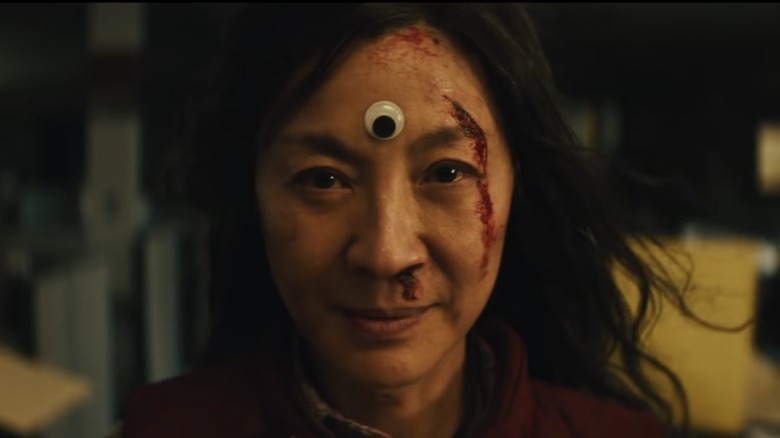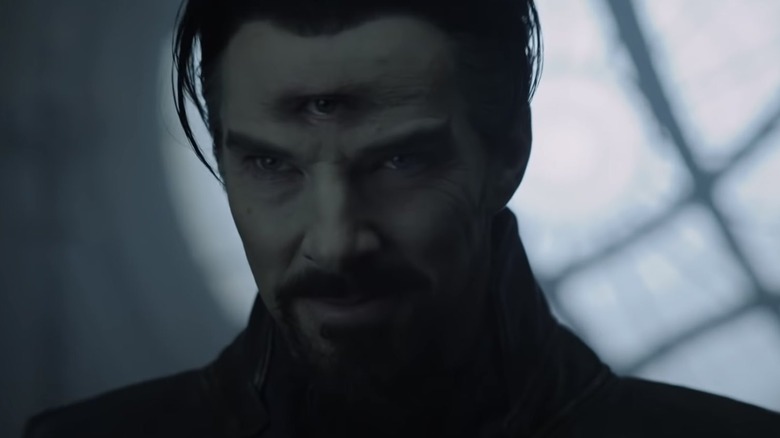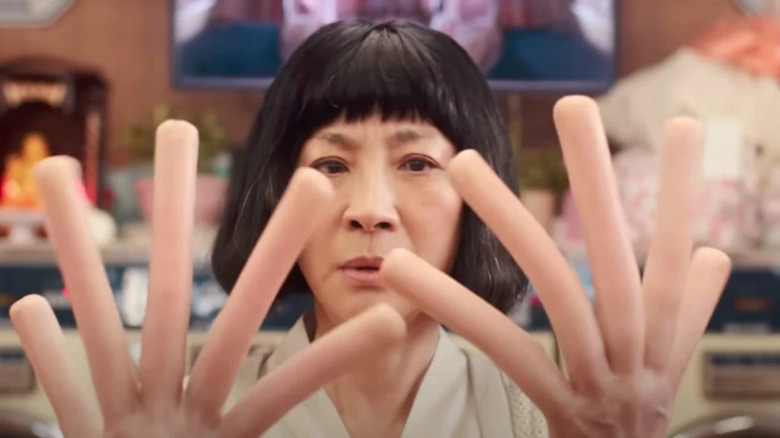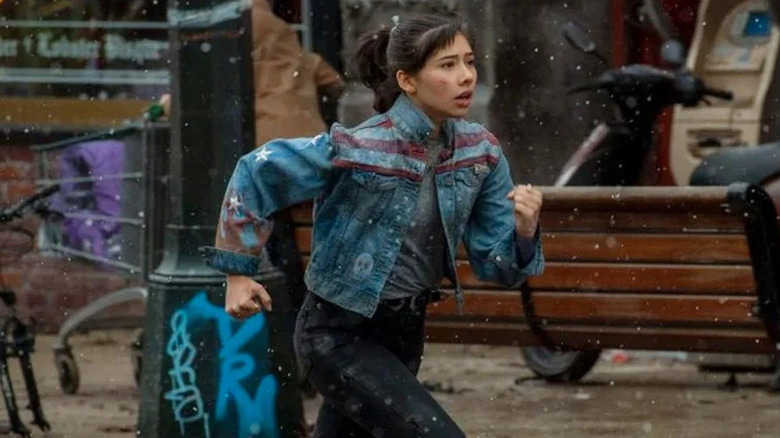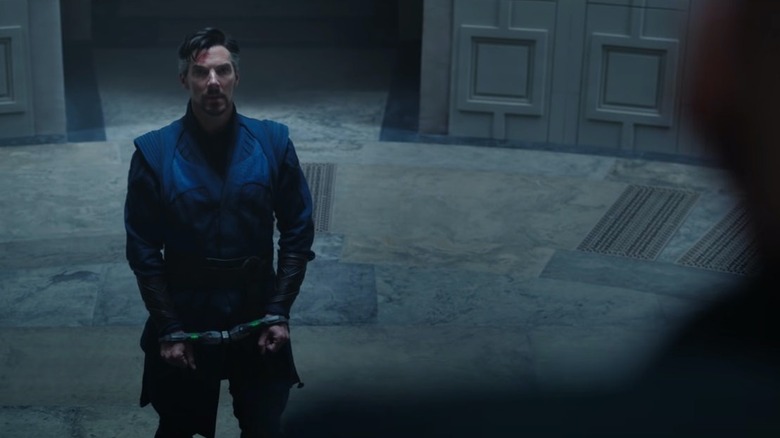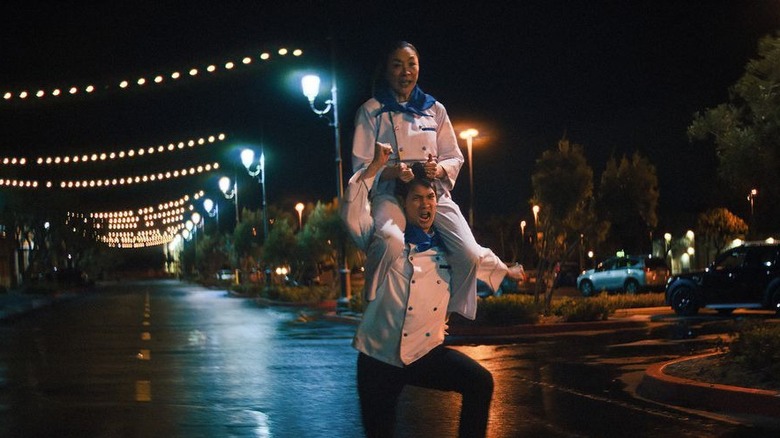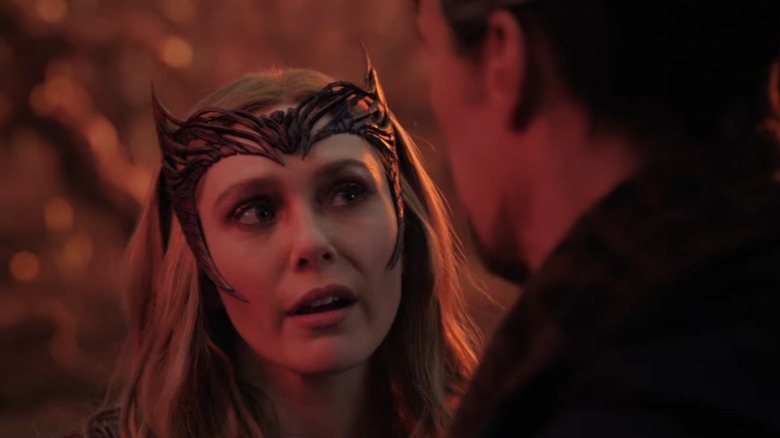Everything Everywhere All At Once Is The Superior Multiverse Of Madness Movie
Potential spoilers for both "Everything Everywhere All At Once" and "Doctor Strange in the Multiverse of Madness" follow.
There was something slightly depressing about watching "Doctor Strange in the Multiverse of Madness" in theaters this week. There was a lot to love about this movie: Elizabeth Olson gave an amazing performance as Wanda, and because Sam Raimi was given some freedom to do his thing, we got to enjoy the first Marvel movie in a while that was genuinely scary. Wanda's murder spree was incredibly violent, feeling real in a way that sets this movie apart from the rest of the MCU. Watching Wanda chase after America Chavez (Xochitl Gomez) like the Terminator going after John Connor was a lot of fun.
However, didn't we just see a movie centered around the multiverse, one that utilized the concept's storytelling potential to a much greater degree? That movie was "Everything Everywhere All at Once," centered around a tired, overworked laundromat owner Evelyn Wang (Michelle Yeoh) who finds herself being forced to traverse the multiverse in order to defeat a villain with universe-hopping abilities. Despite their similar plots, "Everything Everywhere All at Once" is more consistently full of life and excitement. While Raimi did a great job directing the film's horror elements, everything involving the multiverse itself felt lacking.
What's so exciting about the multiverse, anyway?
There's been a lot of interest in exploring parallel universes in the past decade of TV and film. Even "Twin Peaks: The Return" and "Mr. Robot" dabbled with the idea in their finales, letting its main character attempt to live in a universe where things seemed better. The core reason why writers and audiences seem drawn to parallel universes, one that "Everything Everywhere All At Once" understands clearly, is because it tempts us with the idea that we can escape to a world where things are easier. Evelyn gets to experience a universe where she's a martial arts protégé or a talented hibachi chef, a clear step-up from her current life as a working-class immigrant who's seemingly one mistake away from losing her laundromat. This gives her a clear character arc for the movie to center itself around: after experiencing every parallel universe in the multiverse, she realizes she'd still rather stay in the life she currently has.
"Multiverse of Madness" understands this when it comes to its villain, Wanda. She's enthralled by a parallel universe in which she has two loving kids, and will stop at nothing to experience that universe for herself. It's a good arc and, in what's standard for a multiverse story, she eventually comes to terms with the fact that her goal of escaping her current life isn't worth attaining. What about Stephen, though?
When it comes to Doctor Strange, the movie's strangely uninterested in tempting him in the way Evelyn and Wanda are tempted. Whereas Evelyn is initially established as the worst version of herself, the Doctor Strange we follow throughout the film is established to be superior to all the other Doctor Stranges in the multiverse. There's also no universe shown where he and Christine (Rachel McAdams) end up together, which seems like a missed opportunity. If you're going to let your protagonist experience multiple universes, at least one of them should be better than his own.
A lack of imagination
Both movies do similar tricks with the multiverse. They both feature a handful of realistic universes, one where we can basically understand how things ended up the way they did, as well as a handful of absurd universes that clearly don't make sense but make for a fun idea. "Everything Everywhere All At Once" has the "hot dogs for fingers" universe, and "Multiverse of Madness" has the "everything is paint" universe.
The difference is that the paint universe is a one-off gag, whereas the hot-dog-fingers universe is used as an opportunity to show a kinder side to one of the movie's antagonists, Deirdre (Jamie Lee Curtis), and it contributes to the core ideas of the film. "Even when we have hot dogs for hands, we learn to get good with our feet," Evelyn says at one point. It's absurd, but it also ties into the whole theme of how humans can make the best of their bad situations as long as they're open to new ideas and experiences. With the paint universe, "Multiverse of Madness" takes the "haha, so random" aspect of the hot dog universe but doesn't go any further with it.
Both movies also have a character who can hop from universe to universe: America in "Multiverse" and Joy (Stephanie Wsu) in "Everything Everywhere All At Once." Both America and Joy are characters the protagonist has disappointed multiple times in the first act of the film: an alternate Doctor Strange betrays America for the greater good in the opening scene, and Evelyn fails to support her daughter Joy's relationship with another girl in any meaningful way. The difference is that Joy is a fully fleshed-out character who has a consistently strong impact on the plot, whereas America is a plot device who spends most of the movie being escorted from place to place to avoid Wanda getting to her.
More coherent character arcs
The other difference between Joy and America is that Joy's distrust of Evelyn is a lot more compelling than America's distrust of Strange. Doctor Strange has to work to prove that he won't betray America, but her distrust of him is never really Strange's fault. It was an alternate version of Strange that screws her over in the beginning, and when Strange accidentally reveals her location to the person trying to kill her, it's an accident, not some sign of a legitimate character flaw Strange needs to work on.
Evelyn, meanwhile, is genuinely not a good mom in the first third of the movie. She doesn't listen to her daughter's concerns and she's consistently inconsiderate of her feelings. She's also clearly disappointed in Joy being a lesbian, even if she claims she doesn't care. Although the film establishes early on that Evelyn wants to be able to connect with her daughter, early movie Evelyn is a coward. Instead of saying something real to Joy before she leaves the laundromat as she clearly intended, she chickens out and gives her a colder but less vulnerable talk about how Joy's gained weight. Evelyn is introduced to us as a small-minded, somewhat selfish person, and its by gaining experience and perspective that she learns to be better.
Doctor Strange has no such arc. He earns America's trust by being the person we've already known him to be. There's a bit of an arc for both characters where he chooses to trust America to use her own powers rather than take her powers away from her (thus killing her) for the greater good, but there's nothing cathartic about this resolution because there was never any real fear that he'd actually do this. Our version of Strange is never really tempted with that decision until the final scene.
Fan-service cameos
The main reason why "Multiverse of Madness" doesn't seem to take full advantage of its multiverse concept is because this is a Marvel movie. It can't just be a complete story that stands on its own, it also has to set up later movies and TV shows for other characters, and provide cool cameos for the audience to cheer at. Yes, the introduction of Hayley Atwell's Captain America and John Krasinski's Reed Richards got plenty of applause in my theater, but the whole thing felt kind of hollow to me. Professor X and Mister Incredible aren't being organically introduced into this story; they're here because Marvel got the rights back to the "X-Men" and "Fantastic Four" franchises and this is them setting the groundwork for future movies. It's an unavoidable aspect of most Marvel movies by this point, but it's still a little frustrating to watch a scene and know what's happening here is a clear studio note.
Sam Raimi may have had more freedom than previous Marvel directors in this movie, but it's nothing compared to the creative control of directors Dan Kwan and Daniel Scheinert (collectively known as "Daniels") had with "Everything Everywhere All at Once." Entirely unconcerned with setting up a sequel or contributing to a larger cinematic universe, "Everything Everywhere All At Once" is allowed to be bolder and more complete. It's allowed to introduce weird universes and stick with them throughout the movie, rather than bring them in for a simple five-second joke. With the most prominent universe in "Multiverse of Madness," its big quirk is that red lights mean go and green lights mean stop. It's kind of a funny idea, but man is it so much less imaginative than pretty much any of the universes in "Everything Everywhere All At Once."
Third eyes and universe-hopping
Both movies also introduce the ability for characters to control another version of themselves from a different universe. Wanda does this the most, using it not just to go on a murder rampage but to spend time with the kids she has in said alternate universe. Her two sons in this world are almost annoyingly perfect; they seem to want purely to do and say cute things for their mother, who lives alone with her kids in a conflict-free existence for our Wanda to envy. There's no hint of Vision in this universe, but Wanda seems unconcerned.
In "Everything Everywhere All At Once," there's an important point made in Evelyn's scenes in her ideal parallel universe where she's talking to her alternate husband. This perfect life, where she's rich and successful, isn't as perfect as it seems. Although Waymond (Ke Huy Quan) is also successful in this world, he mourns the life he could've had with Evelyn, telling her he would've loved to have been poor and constantly stressed out if it meant being with her. "Multiverse of Madness" plays this alternate universe for Wanda completely straight, however: her arc ends with the movie arguing that this life is in fact as perfect as she thinks it is; she just can't have it. It's not an inherently bad way to handle things, but it's less interesting than "Everything Everywhere All At Once"'s take on the same concept.
Both films also involve the protagonist sporting a third eye. With Evelyn, it's a googly eye, meant more as a symbolic representation of the character embracing empathy. The googly eye with its black pupil surrounded by white is a contrast to Joy's everything bagel, which is pitch black with a bit of white in the middle. The third eye in "Multiverse" is much more literal: it's an actual eye that offers the evil Doctor Strange actual powers. Neither of these directions is worse than the other on their own, but it's indicative of how much more
"Everything Everywhere All At Once" wraps its elements around the protagonists' emotional arc, rather than using it almost entirely to further the plot.
Luckily, it's not a contest
"Everything Everywhere" co-director Daniel Kwan seems to have nothing but goodwill towards "Doctor Strange in the Multiverse of Madness," having recently tweeted "Who wore it better?" referring to images of Doctor Strange and Evelyn both wearing their third eye. He followed the tweet up by saying, "I'm just nerding out because we are having our very own Deep Impact/Armageddon moment and I LOVE twin films."
It certainly does feel like a cool coincidence that two movies with such a similar premise came out within such a short period of time. Variety recently caught some flak on Twitter for seemingly attributing the success of "Everything Everywhere All at Once" primarily to audiences being excited by the multiverse concept, speculating that "ticket buyers really love the concept of a multiverse." Writer and director Ted Geoghegan's sarcastic response to the tweet sums up what most of the backlash came down to: "I, for one, definitely did not see this film because of its amazing cast, beautiful story, incredible representation, or the stunning pedigree of its talented directors. I only saw it because of [the] multiverse."
Although many fear that Hollywood's going to get the wrong idea from "Everything Everywhere All At Once"'s success, "Multiverse of Madness" shows us that Marvel, at least, understands the multiverse alone isn't enough to keep audiences engaged. Sam Raimi's take on the concept doesn't quite reach the levels of the Daniels', but there was still plenty of talent and passion behind this project, and that's what matters most. As much as I'd argue that "Everything Everywhere All At Once" is a more thought-provoking and overall compelling film, "Multiverse of Madness" is still one of the most unique movies Marvel's produced in a long time, and a promising sign for things to come.
